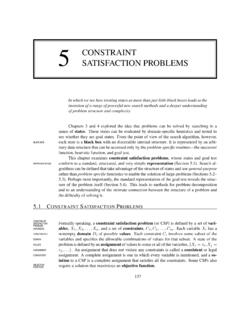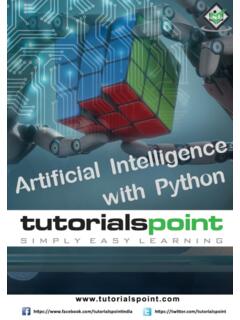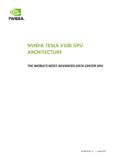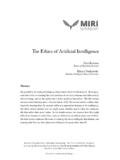Transcription of Knowledge Representation and Reasoning - Stanford University
1 Knowledge Representation and ReasoningCS227 Spring 2011 Teaching Staff Lecturer: Vinay K. Chaudhri Office Hours: After class and by appointment, Gates 195 TA: Zahra Mohammadi Zadeh Office Hours: TBAO utline Three Example Systems Goals / Design of the course Some Basic DefinitionsExample Systems We will take a look at three implemented systems Cognitive Assistant (SIRI) Smart Textbook (Inquire) Computational Knowledge Engine (Wolfram Alpha) For each system, we will look at What Knowledge must it represent? What Reasoning must it do? What would it take to extend it? Where does it fail? How is it different from (current) Google?Cognitive Assistant SIRI See Demo at: What Knowledge must it represent? Restaurants, movies, events, reviews.
2 Location, tasks, web sources, .. What Reasoning must it do? Nearest location, date for tomorrow, AM vs PM, etc What would it take to extend it? More sources, different sources, Where does it fail? Completely different environment, completely different task Differences from Google Dialog driven, task-oriented, location aware, ..Smart Textbook Inquire What Knowledge must it represent? (Demo in the class) Concepts, definitions, relationships, descriptions What Reasoning must it do? Follow relationships, answer questions What would it take to extend it? Must be customized to a new domain, must have methods for handling each kind of question Where does it fail? Does not capture all the content in the book, limited forms of Reasoning How is it different from Google?
3 Very specific domain targeted at a specific class of user situated in an educational contextWolfram Alpha Try out examples at: We will focus on the nutrition example What Knowledge must it represent? Different kinds of foods, their nutrition composition, caloric values What Reasoning must it do? Mathematical computations based on portions What would it take to extend it? Add more data on foods and nutrition composition Where does it fail? Does not know about recipes, how to combine foods, .. How is it different from Google? Data driven as opposed to document driven, mathematical reasoningGoals of the Course Introduction to techniques used to represent symbolic Knowledge Associated methods of automated Reasoning The three systems that we saw use symbolic Knowledge Representation and Reasoning But, they also use non-symbolic methods Non-symbolic methods are covered in other courses (CS228, CS229.)
4 This course would be better labeled as a course on Symbolic Representation and Reasoning The non-symbolic representations are also Knowledge representations but are not covered in this courseDesign of the Course Textbook: Knowledge Representation & Reasoning by Brachman & Levesque (available online) Lectures Tuesday and Thursday, 12:50-2:05, 300-300 Grades Four Assignments (40%), Mid-term (25%), Final (35%) Prerequisites First order logic and Resolution (at the level of CS157) There will be two tutorial sections to cover this material The textbook chapters 2-4 provide adequate background Discrete mathematics (data structures and algorithms) A course in AI ( Knowledge of Lisp or Prolog)Design of the Course Course website Topics: Object-oriented Representation , description logics, ontologies, logic programming , constraint programming , action Representation and Reasoning , abstraction/reformulation/approximation Tests Mid-term, Date: TBA Will be held in the evening Please let us know about any conflicts ASAP Final, Date: TBA Staff mailing list Projects Only with the approval of the instructorDesign of this Course Will this course require programming ?
5 We will work with several off-the-shelf Representation and Reasoning tools We will not be writing any new tools from scratch The focus will be on applying Representation techniques to real world Knowledge and using existing tools to reason with that Knowledge Minor programming may be needed for some assignmentsRelationship to Other Courses This course is a good follow up to CS157: Computational Logic CS221: Introduction to artificial intelligence CS270: Modeling Bio-Medical Systems This course is complementary to: CS228: Probabilistic Graphical Models This course can be followed by: CS223: Rational Agency and Intelligent Interaction CS224: Multi-agent systems CS227B: General Game Playing Application of techniques in your respective projects Research opportunities in symbolic Representation and reasoningMini Project Represent a chapter from a Biology textbook and answer the questions at the back of the book It is high school level Knowledge and each of us should know it Develop confidence in approaching any domain with the formal tools you will learn in this course Primary focus on Representation and Reasoning Provides natural progression: one question, multiple questions, novel questions Structured representations, inference rules, special purpose reasonersOutline Three Example Systems Goals / Design of the course Some Basic DefinitionsWhy KR&R?
6 KR Hypothesis (Brian Smith) Any mechanically embodied intelligent process will be comprised of structural ingredients that We as external observers naturally take to represent a propositional account of the Knowledge that the overall process exhibits Independent of such external semantic attribution, play a formal but causal and essential role in engendering the behavior that manifests that Knowledge Two issues: existence of structures that We can interpret Determine how the system behavesAdapted from Brachman & Levesque 2005 Benefits of Explicit Representation We can add new tasks and easily make them depend on previous Knowledge Enumerating objects vs painting objects Extend the existing behavior by adding new beliefs Assert that canaries are yellow Debug faulty behavior by locating the erroneous beliefs By changing the color of sky we change any routine that uses that information Explain and Justify the behavior of the system The program did X because YBenefits of Reasoning Given Patient X allergic to medication M Anyone allergic to medication M is also allergic to medication M Reasoning helps us derive Patient X is allergic to medication M KR&R and AI
7 KR&R started as a field in the context of AI research Need explicitly represented Knowledge to achieve intelligent behavior Expert systems, language understanding, .. Many of the AI problems today heavily rely on statistical Representation and Reasoning Speech understanding, vision, machine learning, natural language processing For example, the recent Watson system relies on statistical methods but also uses some symbolic Representation and Reasoning Some AI problems require symbolic Representation and Reasoning Explanation, story generation Planning, diagnosis Abstraction, reformulation, approximation Analogical Reasoning KR&R today has many applications outside AI Bio-medicine, Engineering, Business and commerce, Databases, Software engineering, EducationSome Long-Term Problems that need Knowledge Representation Read a chapter in a textbook and answer questions at the end of the chapter Einstein in a box.
8 The quality of Reasoning that distinguishes an ordinary human from a top scientist Answer the same questions as a national academy of science member Learn how to repair a mobile robot and successfully demonstratethe capability by repairing one on Mars Encyclopedia on Demand Produce a 5000 word or less encyclopedia style article on a given subject by summarizing from the relevant information available on the web in less than 24 hoursSuggested Readings Required Reading Chapter 1 of Brachman & Levesque textbook Chapters 2-4 if you do not have prior background in FOL Optional Readings Three Open Problems in AI. Raj Reddy. In the Journal of ACM, Vol50, No. 1, 2003. Some Challenges and Grand Challenges for Computational intelligence . Edward A. Feigenbaum. In the Journal of ACM, Vol 50, No.
9 1, 2003. Systems that Know What they re Doing. Ron Brachman. Intelligent Systems, Vol 17, no. 6, pp 67-71.















